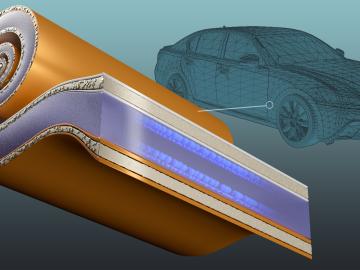Filter News
Area of Research
- Advanced Manufacturing (3)
- Biological Systems (3)
- Biology and Soft Matter (1)
- Building Technologies (2)
- Chemical and Engineering Materials (2)
- Chemistry and Physics at Interfaces (6)
- Computational Chemistry (1)
- Energy Frontier Research Centers (7)
- Energy Science (42)
- Functional Materials for Energy (6)
- Fusion Energy (1)
- Geographic Information Science and Technology (2)
- Isotope Development and Production (1)
- Materials (39)
- Materials Synthesis from Atoms to Systems (5)
- Materials Under Extremes (6)
- Neutron Data Analysis and Visualization (2)
- Neutron Science (10)
- Nuclear Science and Technology (6)
- Quantum Condensed Matter (2)
- Reactor Technology (1)
- Supercomputing (21)
- Transportation Systems (2)
News Type
Date
News Topics
- 3-D Printing/Advanced Manufacturing (10)
- Advanced Reactors (4)
- Artificial Intelligence (18)
- Big Data (6)
- Bioenergy (14)
- Biology (18)
- Biomedical (5)
- Biotechnology (12)
- Buildings (1)
- Chemical Sciences (5)
- Clean Water (1)
- Composites (2)
- Computer Science (11)
- Critical Materials (1)
- Environment (4)
- Exascale Computing (10)
- Fossil Energy (1)
- Frontier (7)
- Fusion (7)
- Grid (3)
- High-Performance Computing (14)
- Isotopes (3)
- ITER (1)
- Machine Learning (6)
- Materials (3)
- Materials Science (8)
- Microscopy (3)
- Molten Salt (1)
- Nanotechnology (4)
- National Security (5)
- Neutron Science (8)
- Nuclear Energy (13)
- Partnerships (8)
- Physics (3)
- Polymers (2)
- Quantum Computing (9)
- Quantum Science (14)
- Security (1)
- Simulation (7)
- Space Exploration (3)
- Summit (4)
- Transportation (3)
ORNL's Communications team works with news media seeking information about the laboratory. Media may use the resources listed below or send questions to news@ornl.gov.
1 - 10 of 385 Results

ORNL set a new milestone in nuclear component innovation, successfully testing two 3D-printed stainless steel experimental capsules at the lab’s High Flux Isotope Reactor. This achievement marks an important step in demonstrating that additively manufactured components can meet the rigorous safety standards required in nuclear applications.

DOE’s Argonne, Idaho, and Oak Ridge National Laboratories co-hosted the AI x Nuclear Energy Executive Summit: Unleashing the Power for AI. It brought together leaders from national labs, tech companies and the nuclear energy industry to discuss how to meet AI’s energy needs and accelerate nuclear energy via AI.

Six entrepreneurs comprise the next cohort of Innovation Crossroads, a DOE Lab-Embedded Entrepreneurship Program node based at ORNL. The program provides energy-related startup founders from across the nation with access to ORNL’s unique scientific resources and capabilities, as well as connect them with experts, mentors and networks to accelerate their efforts to take their world-changing ideas to the marketplace.

More than a year ago, ORNL computational scientists raised concerns about the accuracy of using a 2-femtosecond time step in liquid water simulations. A new study confirms and deepens those concerns, revealing even greater potential for error than previously thought.

ORNL and JuggerBot 3D, an industrial 3D printer equipment manufacturer, have launched their second research and development collaboration through the Manufacturing Demonstration Facility Technical Collaboration Program.

United Rare Earths has licensed two innovative technologies from Oak Ridge National Laboratory aimed at reducing dependence on critical rare earth elements.

A former intern for ORNL was selected to represent Tennessee presenting his research at the National Junior Science and Humanities Symposium. Langalibalele “Langa” Lunga, a senior at Farragut High School in Knoxville, Tennessee, interned with ORNL working on deep learning for fast scanning microscopy, a technique for capturing microscopic images more rapidly than traditional methods.

Strengthening the competitiveness of the U.S. transportation industry depends on developing domestic EV batteries that combine rapid charging with long-range performance — two goals that often conflict. Researchers at ORNL have addressed this challenge by redesigning a key battery component, enabling fast, 10-minute charging while improving energy density and reducing reliance on copper.

From decoding plant genomes to modeling microbial behavior, computational biologist Priya Ranjan builds computational tools that turn extensive biological datasets into real-world insights. These tools transform the way scientists ask and answer complex biological questions that advance biotechnology breakthroughs and support cultivation of better crops for energy and food security.

Scientists have developed a new machine learning approach that accurately predicted critical and difficult-to-compute properties of molten salts, materials with diverse nuclear energy applications.

